Charmouth Mudstone Formation
The Charmouth Mudstone Formation is a geological formation in England. It preserves fossils dating back to the early part of the Jurassic period (Sinemurian–Pliensbachian).[1] It forms part of the lower Lias Group. It is most prominently exposed at its type locality in cliff section between Lyme Regis and Charmouth (alongside the underlying Blue Lias) but onshore it extends northwards to Market Weighton, Yorkshire, and in the subsurface of the East Midlands Shelf and Wessex Basin. The formation is notable for its fossils, including those of ammonites and marine reptiles and rare dinosaur remains. The formation played a prominent role in the history of early paleontology, with its Lyme Regis-Charmouth exposure being frequented by fossil collectors including Mary Anning.
| Charmouth Mudstone Formation Stratigraphic range: Lower Sinemurian– Lower Pliensbachian Semicostatum-lowermost Margaritatus 198–188 Ma | |
|---|---|
 Cliffs of the Charmouth Mudstone Formation at Charmouth, Dorset | |
| Type | Formation |
| Unit of | Lias Group |
| Sub-units | Shales With Beef Member, Black Ven Marl Member, Belemnite Marl Member, Green Ammonite Member |
| Underlies | Dyrham Formation, Marlstone Rock Formation, unconformity with Gault (Charmouth area) |
| Overlies | Blue Lias Formation, Scunthorpe Mudstone |
| Area | Wessex Basin, Worcester Basin, East Midland Shelf |
| Thickness | ~335 m |
| Lithology | |
| Primary | Shale, mudstone |
| Other | Limestone, sandstone |
| Location | |
| Region | England |
| Country | |
| Type section | |
| Named for | Charmouth |
| Location | Cliff and foreshore exposures between Seven Rock Point and Golden Cap, Dorset |
Stratigraphy
Shales With Beef Member
The Shales With Beef Member is around 28–30 metres thick in the Lyme Regis-Charmouth region and predominantly consists of thinly bedded medium to dark grey mudstone, blocky calcareous pale-weathering mudstone and brown-grey organic-rich mudstones with frequent bedding parallel veins of fibrous calcite ("beef"), that are usually less than 10 centimetres thick. Several beds of nodular and tabular limestone are also present. It is the lowest unit of the formation and directly overlies the Blue Lias Formation, with the boundary being marked by a prominent bioturbated horizon. Notable persistent marker beds within the member include the laminated calcareous siltstone "Fish Bed", "Table Ledge", which consists of lens beds of limestones with mud content with nests of rhynchonellid brachiopods, the Devonshire Head and the Spittles limestones and the Birchi Nodules (which are septarian concretions) The upper boundary with the Black Ven Marl Member is marked by the prominent laterally persistent limestone Birchi Tabular Bed.[2]
Black Ven Marl Member
The Black Ven Marl Member is around 43 metres thick consists of thinly bedded dark mudstones,[3] with several laterally persistent cementstone horizons, notable horizons include the Lower and Upper Cement beds and the Stellare nodules.
Belemnite Marl Member
The Belemnite Marl Member is around 20 to 27 metres thick, and consists of interbedded pale and dark grey calcareous mudstone, with numerous belemnites, hence the name. The top of the member is marked by the Belemnite Stone Bed[4]
Green Ammonite Member
The Green Ammonite Member is up to 31 metres thick predominantly consists of medium grey mudstones, with 3 limestone horizons, Lower Limestone; Red Band, and Upper Limestone, it is conformably overlain by the Dyrham Formation in some areas,[5] but in the Charmouth area there is an erosive unconformable boundary with the much younger Albian aged Gault clays.
Paleobiota
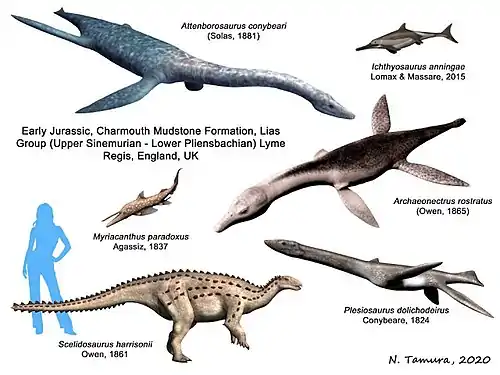
Ammonites
| Ammonites of the Charmouth Mudstone Formation | ||||||
|---|---|---|---|---|---|---|
| Genus | Species | Location | Stratigraphic position | Material | Notes | Images |
| Apoderoceras | A. cf. dunrobinense, A. subtriangulare | |||||
| Arnioceras | A. semicostatum | Semicostatum Zone | ||||
| Asteroceras | A. obtusum | Obtusum zone | 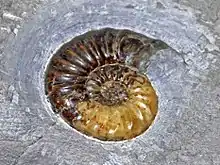 | |||
| Caenisites | ||||||
| Cymbites | ||||||
| Echioceras | E. raricostatum | Raricostatum Zone | ||||
| Eoderoceras | E. bispinigerum | |||||
| Gemmellaroceras | G. cf. peregrinum | Belemnite Marls | ||||
| Oxynoticeras | O. williamsi | |||||
| Phricodoceras | P. taylori, P. lamellosum | Belemnite Marls | ||||
| Promicroceras | P. planicosta | Obtusum Zone | 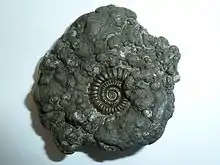 | |||
| Radstockiceras | R. complicatum | |||||
| Tragophylloceras | T. ibex, T. loscombi | Green Ammonite Member | ||||
| Xipheroceras | ||||||
Sauropterygia
| Sauropterygia of the Charmouth Mudstone Formation | ||||||
|---|---|---|---|---|---|---|
| Genus | Species | Location | Stratigraphic position | Material | Notes | Images |
|
Archaeonectrus rostratus |
Charmouth |
Arnioceras semicostatum-Echioceras raricostatum ammonoid zone |
BMNH 38525 (holotype skeleton) |
A marine sauropterygian, member of the family Rhomaleosauridae |
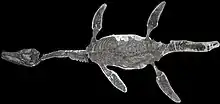 | |
|
Attenborosaurus conybeari |
|
Asteroceras obtusum, Arnioceras semicostatum-Echioceras raricostatum ammonoid zones |
|
A marine sauropterygian, early member of the family Pliosauridae. It was identified as Plesiosaurus conybeari. |
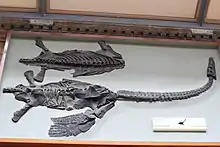 Cast of the holotype | |
|
? Plesiosaurus sp. |
|
Prodactylioceras davoei ammonoid zone |
|
A marine sauropterygian, type member of the family Plesiosauroidea inside Plesiosauria. A Juvenile specimen that resembles those assigned to the genus Plesiosaurus. It's assignation is rather dubious. |
||
|
Plesiosaurus dolichodeirus |
|
Echioceras raricostatum ammonoid zone |
|
A marine sauropterygian, type member of the family Plesiosauroidea inside Plesiosauria. The typical plesiosaur, and one of the most common found on the formation. |
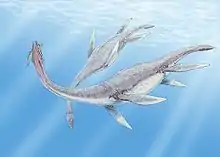 Reconstruction | |
| Thaumatodracon[10] | T. wiedenrothi | Between Lyme Regis and Charmouth | Black Ven | NLMH 106.058, "a partial skeleton comprising a complete cranium, mandible, articulated cervical series, and indeterminate fragmentary remains" | A rhomaleosaurid | |
Ichthyosauria
| Ichthyosauria of the Charmouth Mudstone Formation | ||||||
|---|---|---|---|---|---|---|
| Genus | Species | Location | Stratigraphic position | Material | Notes | Images |
|
Ichthyosaurus anningae[11] |
Charmouth |
Stonebarrow Marls Member |
DONMG:1983.98 Subadult specimen |
 | ||
|
Ichthyosaurus sp. |
West of Westhay Water, Stonebarrow |
Stonebarrow Marls Member |
NHMUK R15907, partial skeleton[12] |
Considered to belong to I. communis by Bennett et al. 2012, considered indeterminate within Ichthyosaurus by Lomax and Massare 2015 |
||
|
Leptonectes moorei[13] |
Seatown |
Belemnite Marls Member |
BMNH R14370 partial anterior skeleton with most complete skull |
Leptonectid Ichthyosaur |
||
|
Leptonectes solei[14] |
Seatown |
Acanthopleuroceras valdani Subzone, Tragophylloceras ibex Zone, lower Pliensbachian |
NMW 91.296.2.2 "a large, isolated and incomplete forefin" |
|||
Pterosauria
| Pterosauria of the Charmouth Mudstone Formation | ||||||
|---|---|---|---|---|---|---|
| Genus | Species | Location | Stratigraphic position | Material | Notes | Images |
|
Dimorphodon macronyx |
|
Black Ven Marl Member |
|
A basal Pterosaur, type member of the family Dimorphodontidae. This is one of the most know genera of lower Jurassic pterosaurs recovered, know by its large head. The knowledge of how Dimorphodon lived is limited. It perhaps mainly inhabited coastal regions and might have had a very varied diet. Buckland suggested it ate insects. Later, it became common to depict it as a piscivore (fish eater), though Buckland's original idea is more well supported by biomechanical studies, and inconsistent with the animal's habits (see flight below). Dimorphodon had an advanced jaw musculature specialized for a "snap and hold" method of feeding. |
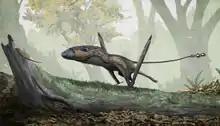 | |
|
Indeterminate |
|
Black Ven Marl Member |
|
A basal Pterosaur, member of the family Dimorphodontidae. Known as "Charmouth dimorphodontid" it shares resemblance with the genus Dimorphodon. |
||
|
Indeterminate |
|
Lower Pliensbachian member |
Associated remains of the rostrum and mandibles |
A basal Pterosaur, member of the family Dimorphodontidae. The relatively deep rostrum and extreme size dimorphism in the dentition show clear similarities to Dimorphodon, also from the Lias of Dorset. The distinctive dentition, in which the first four pairs of rostral teeth and two pairs of mandibular teeth are relatively large and fang-like, while the remaining teeth are remarkably small and short.[19] |
||
Dinosauria
| Dinosauria of the Charmouth Mudstone Formation | ||||||
|---|---|---|---|---|---|---|
| Genus | Species | Location | Stratigraphic position | Material | Notes | Images |
|
Scelidosaurus harrisonii |
|
Black Ven Marl Member |
|
A basal Thyreophoran, type member of the family Scelidosauridae. One of the best known armored dinosaurs of the lower Jurassic, also the most complete found to date, with specimens preserving even the skin and dermal armour.[23] |
.jpg.webp) | |
|
Scelidosaurus sp. A[24] |
Belemnite Marls at Seatown |
|
DORCM G.7842. Three dorsal vertebrae in articulation | |||
|
Foot of Black Ven, Charmouth |
Asteroceras obtusum ammonoid zone, Black Ven Marl Member |
NHMUK OR39520. Ungual phalanx of ?pes.
| ||||
|
"Merosaurus" newmani |
lower cliff face, Charmouth |
Black Ven Marl Member |
|
A Theropod, possible basal member of Tetanurae. Initially considered part of Scelidosaurus holotype, considered Tetanurae indet by Carrano 2012. It was named "Merosaurus" by Welles, Powell and Pickering in 1995.[30] But due to lack description was considered invalid.[31] |
 | |
|
"Megalosaurus" lydekkeri |
Lyme Regis |
Black Ven Marl Member |
|
A Theropod, possible member of Coelophysidae inside Neotheropoda. Invalid and non diagnostic. It was identified as Zanclodon(?) sp. b., Megalosaurus lydekkeri and reassigned as Magnosaurus(?) lydekkeri.[34] Mortimer found that was changed to "Megalosaurus" woodwardi later.[34] It was found on mostly of recent works to be non diagnostic, probably a Coelophysoid.[33] |
||
|
Indeterminate |
Near Lyme Regis |
obtusum Zone, obtusum subzone |
|
A Theropod, possible basal member of Neotheropoda. Previously misidentified as a referred specimen of the pterosaur Dimorphodon macronyx.[16] NHMUK PV R36855 differs from those of all other Early Jurassic-Late Triassic, theropods in its combination of features, but bears no discernible autapomorphies.[35] It is similar to Tawa, Dracoraptor and Liliensternus, being considered an early branching Neotheropod, with a size range similar to Coelophysis bauri, representing an individual of approximately 10 kg.[35] |
 | |
|
Indeterminate |
lower cliff face, Charmouth |
obtusum Zone, obtusum subzone |
|
A Sauropodomorph, possible member of Massopoda. While it was not associated with BMNH 39496 or GSM 109560 and was not assigned to "Merosaurus" it was classified as coming from an indeterminate theropod. Mortimer found closer resemblance with pedal unguals of basal massopods like Blikanasaurus and Jingshanosaurus.[31] |
||
Insects
Numerous species of insect are known from concretions, predominately in the Black Ven Marl Member.[37][38][39][40]
| Insects of the Charmouth Mudstone Formation | ||||||
|---|---|---|---|---|---|---|
| Genus | Species | Location | Stratigraphic position | Material | Notes | Images |
| Anglophlebia | A. gigantea | NHMUK In.51030, part and counterpart of partial forewing | Damsel-dragonfly | 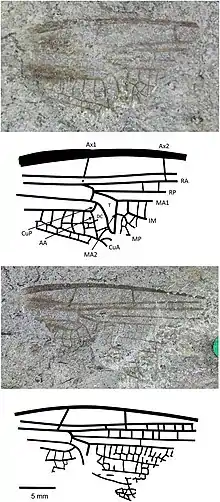 | ||
| Archaeolepis | A. mane | Birchi Nodules, Black Ven | Shales with Beef | Among the oldest known lepidopterans | ||
| Archelcana | A. durnovaria | Woodstones | Black Ven Marl Member | Elcanid orthopteran | ||
| Austaulius | A. haustrum | Monmouth Beach, Lyme Regis | NHMUK II 3103 | Necrotauliid caddisfly | ||
| Brevicula | B. gradus, B. maculata | Flatstones, Woodstones | B. gradus: Holotype: NHMUK In.53993, female with ovipositor, B. maculata: Holotype: NHMUK II.3086, isolated Tegmina | Dermapterid earwig | ||
| Brochocoleus | B. maculatus | Ommatid beetle | ||||
| Chrismooreia | C. michaelbehei | Charmouth | Obtusum Zone | Part and counterpart of a mostly complete specimen | Asiopterid damsel-dragonfly |  |
| Dorsettia | D. laeta | Flatstones | BMNH In 59375, a male hindwing fragment | Campterophlebiid damsel-dragonfly, genus also known from China | ||
| Durnovaria | D. parallela | Flatstones | Aerophasmatid, Stem group of Phasmatodea | |||
| Elaterina | E. liassica | Lyme Regis | Click beetle | |||
| Elaterophanes | E. regius | Flatstones | Click beetle | |||
| Eoptychoptera | E. spectra | Flatstones | Ptychopterid fly, formerly referred to the genus Prodocidia | |||
| Holcoptera | H. giebeli, H. alisonae | Flatstones | Bed 83 of the Obtusum Subchronozone, Black Ven Marl Member | Complete specimen, isolated wings | Coptoclavid beetle | 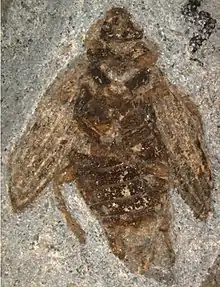 |
| Hypsothemis | H. fraseri | Flatstones | BMNH In 59109, a hindwing | Campterophlebiid damsel-dragonfly, genus also known from China and Kazakhstan | ||
| Jurachorista | J. bashkuevi | Monmouth Beach, Brooki bed | Shales with Beef Member | Eomeropid scorpionfly | ||
| Lateophlebia | L. anglicanopsis | Flatstones | Campterophlebiid damsel-dragonfly | |||
| Liassocorixa | L. dorsetica | Flatstones | Corixid bug | |||
| Liassocupes | L. parvus | Flatstones | Ommatid beetle | |||
| Liassophlebia | L. pseudomagnifica | Stonebarrow | NHMUK In.64000, partial hindwing | Liassophlebiid damsel-dragonfly |  | |
| Locustopsis | L. spectabilis | Flatstones | Locustopsid grasshopper | |||
| "Mesocixiella" | "M." fennahi | Flatstones | Fulgoridiid planthopper, does not belong to the genus Mesocixiella | |||
| Metaraphidia | M. confusa | Black Ven Marl Member | Snakefly | |||
| Micromacula | M. gracilis | Flatstones, Birchi Nodules | Regiatid orthopteran | |||
| Mimemala | M. giganteum | Flatstones | Schizocoleid beetle | |||
| Nannoblattina | N. petulantia | Flatstones | Mesoblattinid cockroach | |||
| Nannotanyderus | N. oliviae | Monmouth Beach, Brooki bed | Shales with Beef Member | Tanyderid fly | ||
| Neomeridium | N. trifurcum | Woodstones | Pachymeridiid Lygaeoid bug | |||
| Omma | O. liassicum | Flatstones | BMNH 59132 | Ommatine beetle, genus extant | ||
| Orthophlebia | O. capillata | Flatstones | BMNH In 53924, an exoskeleton (wings & thorax) | Orthophlebiid scorpionfly | ||
| Paraprosbole | P. rotruda | Flatstones | Tettigarctid cicada | |||
| Propreocoris | P. maculatus | Woodstones | Stem-group to Ochteridae and Gelastocoridae | |||
| Protohagla | P. langi | Flatstones | Haglid cricket | |||
| Protorthophlebia | P. latipennis | Flatstones | Orthophlebiid scorpionfly | |||
| Priscaenigma | P. obtusa | Flatstones | Snakefly | |||
| Pseudopolycentropus | P. triangularis | Woodstones | Black Ven Marl Member | Pseudopolycentropodid scorpionfly | ||
| Pterocimex | P. jacksoni | Woodstones | Black Ven Marl Member | Nepomorphan | ||
| Regiata | R. scutra | Flatstones | Regiatid orthopteran | |||
| Rossiphlebia | R. jacksoni | Flatstones | NHMUK In.53999, part and counterpart of a partial hindwing | Liassophlebiid damsel-dragonfly |  | |
| Tersus | T. crowsoni | Flatstones | NHM, In. 53949 | Schizophorid beetle | ||
References
- British Geological Survey. "Charmouth Mudstone Formation". BGS Lexicon of Named Rock Units. Retrieved 2018-03-08.
- Gallois, R.W. (2008). The lithostratigraphy of the Shales-with-Beef Member of the Charmouth Mudstone Formation, Lower Jurassic (PDF). Ussher Society. OCLC 703253954.
- "Black Ven Marl Member". The BGS Lexicon of Named Rock Units. British Geological Survey.
- "Belemnite Marl Member". The BGS Lexicon of Named Rock Units. British Geological Survey.
- "Green Ammonite Member". The BGS Lexicon of Named Rock Units. British Geological Survey.
- R. Owen. 1865. Part I. Sauropterygia. Monographs on the fossil Reptilia of the Liassic formations 17(75):1-40
- W. J. Sollas. 1881. On a new species of Plesiosaurus (P. Conybeari) from the Lower Lias of Charmouth; with observations on P megacephalus, Stutchbury, and P. brachycephalus, Owen. Quarterly Journal of the Geological Society of London 37:440-480
- G. W. Storrs. 1995. A juvenile specimen of ? Plesiosaurus sp. from the Lias (Lower Jurassic, Pliensbachian) near Charmouth, Dorset, England. Proceedings of the Dorsal Archaelogical and Natural History Society 116:71-76
- W. D. Conybeare. 1824. On the discovery of an almost perfect skeleton of the Plesiosaurus. Transactions of the Geological Society of London, series 2 1:381-389
- Smith, Adam S.; Araújo, Ricardo (2017-07-21). "Thaumatodracon wiedenrothi, a morphometrically and stratigraphically intermediate new rhomaleosaurid plesiosaurian from the Lower Jurassic (Sinemurian) of Lyme Regis". Palaeontographica Abteilung A. 308 (4–6): 89–125. doi:10.1127/pala/308/2017/89. ISSN 0375-0442.
- Lomax, Dean R.; Massare, Judy A. (2015-03-04). "A new species of Ichthyosaurus from the Lower Jurassic of West Dorset, England, U.K.". Journal of Vertebrate Paleontology. 35 (2): e903260. doi:10.1080/02724634.2014.903260. ISSN 0272-4634. S2CID 85745787.
- Bennett, S.P.; Barrett, P.M.; Collinson, M.E.; Moore-Fay, S.; Davis, P.G.; Palmer, C.P. (January 2012). "A new specimen of Ichthyosaurus communis from Dorset, UK, and its bearing on the stratigraphical range of the species". Proceedings of the Geologists' Association. 123 (1): 146–154. doi:10.1016/j.pgeola.2011.07.001.
- McGowan, Christopher; Milner, Angela C. (October 1999). "A new Pliensbachian ichthyosaur from Dorset, England". Palaeontology. 42 (5): 761–768. doi:10.1111/1475-4983.00096. ISSN 0031-0239.
- Lomax, Dean R.; Massare, Judy A. (December 2018). "A forefin of Leptonectes solei from the Lower Jurassic (Pliensbachian) of Dorset, UK". Proceedings of the Geologists' Association. 129 (6): 770–773. doi:10.1016/j.pgeola.2018.07.005.
- Martill, D. M. (2014). Dimorphodon and the Reverend George Howman's noctivagous flying dragon: the earliest restoration of a pterosaur in its natural habitat. Proceedings of the Geologists' Association, 125(1), 120-130.
- Steel, L. (2012). The pterosaur collection at the Natural History Museum, London, UK: an overview and list of specimens, with description of recent curatorial developments. Acta Geologica Sinica‐English Edition, 86(6), 1340-1355.
- Unwin, D. M. (2003). On the phylogeny and evolutionary history of pterosaurs. Geological Society, London, Special Publications, 217(1), 139-190.
- Barrett, P. M., Butler, R. J., Edwards, N. P., & Milner, A. R. (2008). Pterosaur distribution in time and space: an atlas. Zitteliana, 61-107.
- Unwin, D. M. (2011): A new dimorphodontid pterosaur from the Lower Jurassic of Dorset, southern England. 59th Annual Symposium of Vertebrate Palaeontology and Comparative AnatomyLyme Regis, Dorset, UK
- B.H. Newman The Jurassic dinosaur Scelidosaurus harrisoni, Owen Palaeontology, 11 (1968), pp. 40-43
- Charig AJ, Newman BH. 1992. Scelidosaurus harrisonii Owen, 1861 (Reptilia, Ornithischia): proposed replacement of inappropriate lectotype. Bulletin of Zoological Nomenclature 49: 280–283
- David B Norman, FLS, Scelidosaurus harrisonii from the Early Jurassic of Dorset, England: cranial anatomy, Zoological Journal of the Linnean Society, Volume 188, Issue 1, January 2020, Pages 1–81, https://doi.org/10.1093/zoolinnean/zlz074
- David B Norman, FLS, Scelidosaurus harrisonii from the Early Jurassic of Dorset, England: the dermal skeleton, Zoological Journal of the Linnean Society, Volume 190, Issue 1, September 2020, Pages 1–53, https://doi.org/10.1093/zoolinnean/zlz085
- P. C. Ensom. 1989. New scelidosaur remains from the Lower Lias of Dorset. Proceedings of the Dorset Natural History and Archaeological Society 110:166-167
- Anonymous. 1955. British Museum (Natural History). Nature 176(4487):815-816
- Maidment, S.C.R., Porro, L.B., 2010, "Homology of the palpebral and origin of the supraorbital ossifications in ornithischian dinosaurs", Lethaia, 43: 95-111
- Rixon AE. 1968. The development of the remains of a small Scelidosaurus from a Lias nodule. Museums Journal 67: 315–321
- R.B.J. Benson, P.M. Barrett Dinosaurs of Dorset: Part 1, the carnivorous dinosaurs (Saurischia, Theropoda) Proceedings of the Dorset Natural History and Archaeological Society, 130 (2009), pp. 133-147
- M.T. Carrano, R.B.J. Benson, S.D. Sampson The phylogeny of Tetanurae (Dinosauria: Theropoda) Journal of Systematic Palaeontology, 10 (2012), pp. 211-300
- Pickering, 1995. Jurassic Park: Unauthorized Jewish Fractals in Philopatry. A Fractal Scaling in Dinosaurology Project, 2nd revised printing. Capitola, California. 478 pp.
- Mortimer, M.(2010): Pickering's taxa 4: Merosaurus newmani. The Theropod Database Blog
- R. Lydekker Catalogue of the Fossil Reptilia and Amphibia in the British Museum (Natural History). Part I. British Museum (Natural History), London 309 pp (1888)
- M.T. Carrano, S.D. Sampson A review of coelophysoids (Dinosauria: Theropoda) from the Early Jurassic of Europe, with comments on the late history of the Coelophysoidea Neues Jahrbuch für Geologie und Paläontologie, Monatshefte, 2004 (2004), pp. 537-558
- Mortimer, M.(2012):"New" name for Megalosaurus? lydekkeri. The Theropod Database Blog
- Choinierea J. N., Wills, S., Bennett, S.C., Barrett P.M.(2020):A small theropod dinosaur from the Lower Jurassic Lias Group of Charmouth, Dorset. Proceedings of the Geologists' Association. 14 September 2020
- Benson, 2010. The osteology of Magnosaurus nethercombensis (Dinosauria, Theropoda) from the Bajocian (Middle Jurassic) of the United Kingdom and a re-examination of the oldest records of tetanurans. Journal of Systematic Palaeontology. 8(1), 131-146.
- "Flatstones, Charmouth (Jackson collection) (Jurassic of the United Kingdom)". fossilworks.org. Retrieved 2020-08-26.
- "Flatstones, Stonebarrow, Charmouth (Jackson collection) (Jurassic of the United Kingdom)". fossilworks.org. Retrieved 2020-08-26.
- "Flatstones, Black Ven, Charmouth (Jackson collection)". paleobiodb.org. Retrieved 2020-08-26.
- "Woodstones, Black Ven, Charmouth (Jackson collection)". paleobiodb.org. Retrieved 2020-08-26.
